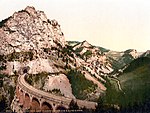World Heritage in Austria - Wikivoyage, the free collaborative travel and tourism guide - Patrimoine mondial en Autriche — Wikivoyage, le guide de voyage et de tourisme collaboratif gratuit
This article lists the sites registered with World Heritage in Austria.
Understand
Austria ratifies the Convention for the Protection of the World Cultural and Natural Heritage on December 18, 1992. The first two protected sites were inscribed in 1996 during the 20th session of the World Heritage Committee.
Austria has 10 World Heritage sites, 9 cultural and 1 natural.
Listing
The following sites are listed as World Heritage.
| Site | Type | Criterion | Description | Drawing |
|---|
| 47.80055613.04331 Historic center of the city of Salzburg | Cultural | (ii), (iv), (vi) | | 
|
| 48.21666716.3830562 Vienna historic center | Cultural | (ii), (iv), (vi) | | .JPG/150px-Wien_-_Stephansdom_(1).JPG)
|
| 47.64877815.8279723 Semmering railway line | Cultural | (ii), (iv) | | 
|
| 48.18666716.313334 Schönbrunn Palace and Gardens | Cultural | (i), (iv) | | 
|
| Fertö Cultural Landscape / 47.71927816.72275 Neusiedlersee | Cultural | (v) | | 
|
| Cultural landscape of 47.56222213.6497226 Hallstatt -47.47605813.6048087 Hoher Dachstein / 47.55944413.6427788 Salzkammergut | Cultural | (iii), (iv) | | 
|
| 48.36444415.4341679 Wachau Cultural Landscape | Cultural | (ii), (iv) | | 
|
| Prehistoric pile-dwelling sites around the Alpsː 47.89471113.53363110 Abtsdorf I ,47.89321113.5331511 Abtsdorf III ,46.58701914.15946112 Keutschacher See ,47.9343513.55471913 Litzlberg Süd ,47.80388113.44928114 Mondsee – See | Cultural | (iv), (v) | | 
|
| 47.07416715.39166715 City of Graz - Historic center and Eggenberg castle | Cultural | (ii), (iv) | | 
|
| Primary beech forests of the Carpathians and other parts of Europe | Natural | (ix) | The site is a transnational extension of the Primary Beech Forests of the Carpathians and Ancient Beech Forests of Germany (Slovakia, Ukraine and Germany) which now spans twelve countries. Since the end of the last Ice Age, the beech forests of Europe have rapidly spread from a few isolated refuges in the Alps, Carpathians, Mediterranean and Pyrenees in a few thousand years, a process which still continues. today. The successful expansion of beech is due to its flexibility and tolerance to different climatic, geographic and physical conditions. |
|
Criteria legend | (i) | Represent a masterpiece of human creative genius. | | (ii) | To testify to a considerable exchange of influences during a given period or in a specific cultural area, on the development of architecture or technology, monumental arts, city planning or the creation of landscapes. | | (iii) | To bring a unique or at least exceptional testimony to a cultural tradition or a living or disappeared civilization. | | (iv) | To be an outstanding example of a type of building, architectural or technological ensemble or landscape which illustrates one or more significant periods in human history. | | (v) | Be a prominent example of traditional human settlement, traditional use of land or sea. | | (vi) | To be directly or materially associated with events or living traditions, ideas, beliefs or artistic and literary works of outstanding universal significance. | | (vii) | Represent natural phenomena or areas of exceptional natural beauty and aesthetic importance. | | (viii) | To be eminently representative examples of the great stages in the history of the Earth. | | (ix) | To be eminently representative examples of ecological and biological processes underway in the evolution and development of ecosystems. | | (x) | Contain the most representative natural habitats and the most important for conservation in situ of biological diversity. |
|
 | These travel tips are usable. They present the main aspects of the subject. While an adventurous person could use this article, it still needs to be completed. Go ahead and improve it! |
| Complete list of other articles in the theme: Unesco World Heritage |

.JPG/150px-Wien_-_Stephansdom_(1).JPG)







